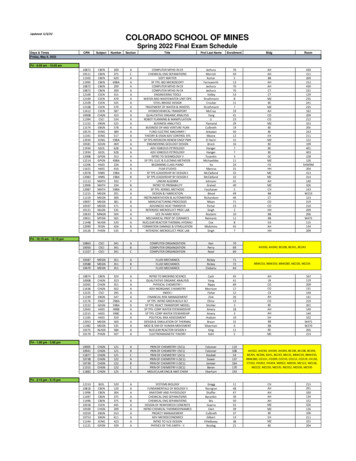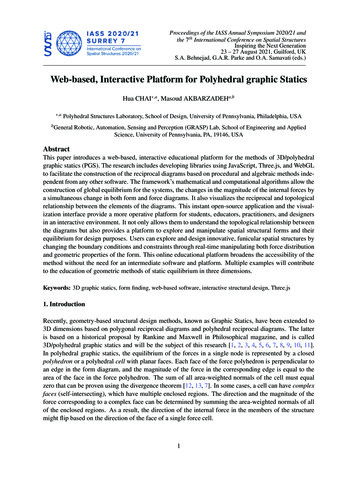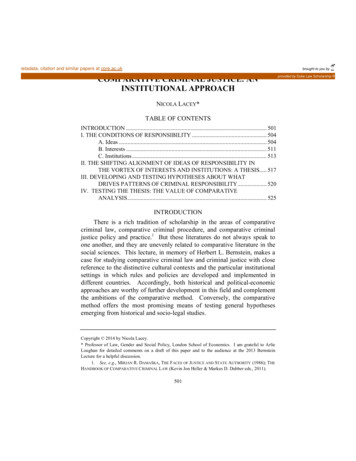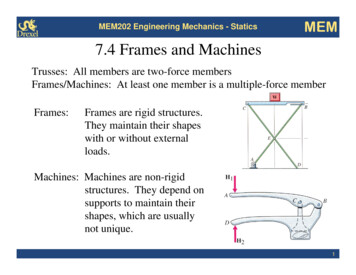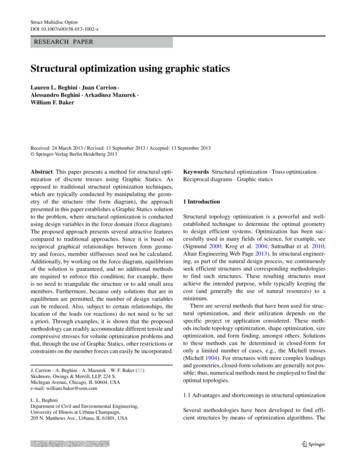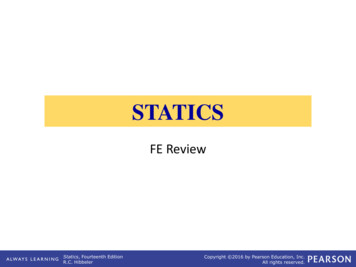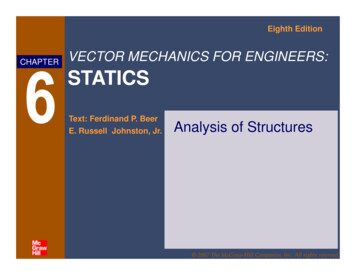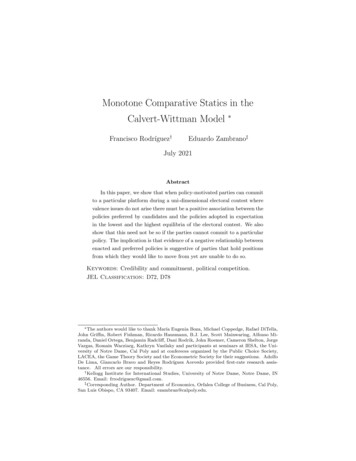
Transcription
Monotone Comparative Statics in theCalvert-Wittman ModelFrancisco Rodrı́guez† Eduardo Zambrano‡July 2021AbstractIn this paper, we show that when policy-motivated parties can committo a particular platform during a uni-dimensional electoral contest wherevalence issues do not arise there must be a positive association between thepolicies preferred by candidates and the policies adopted in expectationin the lowest and the highest equilibria of the electoral contest. We alsoshow that this need not be so if the parties cannot commit to a particularpolicy. The implication is that evidence of a negative relationship betweenenacted and preferred policies is suggestive of parties that hold positionsfrom which they would like to move from yet are unable to do so.Keywords: Credibility and commitment, political competition.JEL Classification: D72, D78 The authors would like to thank Marı́a Eugenia Boza, Michael Coppedge, Rafael DiTella,John Griffin, Robert Fishman, Ricardo Hausmann, B.J. Lee, Scott Mainwaring, Alfonso Miranda, Daniel Ortega, Benjamin Radcliff, Dani Rodrik, John Roemer, Cameron Shelton, JorgeVargas, Romain Wacziarg, Kathryn Vasilaky and participants at seminars at IESA, the University of Notre Dame, Cal Poly and at confereces organized by the Public Choice Society,LACEA, the Game Theory Society and the Econometric Society for their suggestions. AdolfoDe Lima, Giancarlo Bravo and Reyes Rodrı́guez Acevedo provided first-rate research assistance. All errors are our responsibility.† Kellogg Institute for International Studies, University of Notre Dame, Notre Dame, IN46556. Email: frrodriguezc@gmail.com.‡ Corresponding Author. Department of Economics, Orfalea College of Business, Cal Poly,San Luis Obispo, CA 93407. Email: ezambran@calpoly.edu.
1IntroductionThe Downsian model of politics assumes that candidates can commit to keeptheir policy promises once they reach office.Their ability to commit allowsthem to manipulate policy proposals so as to garner the fraction of votes thatmaximizes their probability of winning. Political competition thus leads toconvergence of proposed policies to the median voter’s ideal point. A numberof refinements of this model have been proposed in the literature since Downs’s1957 contribution, many of which have attempted to reverse the problematichypothesis of complete convergence in policy proposals implied by Downsiancompetition.1 Until the late nineties, most of this literature generally took asgiven the underlying assumption of a perfect capacity of candidates to makecredible commitments.2Besley and Coate (1997) and Osborne and Slivinsky (1996), however, showedthat some of the key results of the Downsian model no longer hold in a modelof citizen-candidates in which policymakers are not bound to keep to their campaign promises. In particular, electoral competition need not lead to full oreven partial convergence in policy platforms once candidates lose their abilityto make credible promises. Indeed, a multiplicity of equilibria become feasible,some of which entail very extreme policies being proposed in equilibrium.An extensive literature has developed in the past two decades addressingthe issue of how the citizen-candidate assumptions can be reconciled with theintuition of the spatial competition model. These contributions typically modelrepeated game interactions in which politicians who deviate from their promisesare punished in future elections and thus gain an incentive to hold to theircampaign promises. (Alesina, 1988; Dixit, Grossman and Gul, 2000; Aragonès,Palfrey and Postlewaite, 2007; Panova, 2017). In some settings, politicians maydecide to maintain ambiguity about their preferences either because they do notknow the true preferences of the median voter (Glazer, 1990), wish to provide asignal of their character or avoid reputational risks (Kartik and McAfee, 2007;Kartik and van Weelden, 2019). Empirical tests of the credibility hypothesisinclude comparisons of campaign promises and legislative votes (Sulkin, 2009;Bidwell, Casey and Glennerster 2020), assessments of the effect of term limitson observed policies (Besley and Case, 1995, 2003; Ferraz and Finan, 2011) or1 Usefulsurveys include Mueller (2003), Hinich and Munger(1997), and Roemer (2001).also Crain (2004), Chattopadhyay and Duflo (2004), Lee, Moretti and Butler (2004)and Groseclose (2001). For a useful survey of the citizen-candidate model and its dynamicextensions see Duggan and Martinelli (2015).2 See2
testing for opportunistic policy cycles (Alesina et al., 1997; Shi and Svennson,2006).Investigating whether credibility problems in politics arise and persist is adifficult task, partly because of the problems that the multiplicity of equilibriacreates. Our paper sidesteps these problems in uni-dimensional electoral contests where valence issues do not arise by proposing an alternative way of discriminating between models that assume commitment and those that precludeit. We do this by studying the shape of the expected policy function, whichmaps candidates’ platforms into expected policies. Optimizing candidates thatcan make credible commitments will never situate themselves on a segment ofthat function in which further moderation would drive expected policies to becloser to their ideal points. Doing so would leave unexploited the possibility ofincreasing the expected payoff for the candidates by driving policies closer totheir optimum while increasing their probability of winning the election. Thisis conceptually similar to the notion that a profit maximizing monopolist wouldnot produce in the decreasing region of its revenue function, as reducing outputwould then simultaneously increase its revenues and decrease its costs.Since the platforms chosen by candidates in equilibrium are endogenous,it may be difficult to empirically evaluate hypotheses about the relationshipbetween platforms and policies. In order to address this issue, we show thatthe indirect expected policy function, which maps candidate preferences intoobserved policies, is also always increasing in the ideal policies of the candidatesand can thus be used to investigate whether credibility problems can arise inpractice, even in the presence of multiple equilibria.We illustrate how this resultcan be used to empirically evaluate credibility theories, for example by studyingthe correlation between changes in constituent or political leaders’ preferencesas measured by opinion surveys, and enacted policies.The rest of the paper is organized as follows. Section 2 presents the mainresults of the paper in detail. Section 3 concludes.2SettingThe policy space is the interval T [0, 1] . Voters have ideal policies representedby a point in T . When faced with two policies to choose from, the voter choosesthe policy that is closest in distance to the voter’s ideal policy.Candidate preferences are described by a continuous real-valued payoff func-3
tion u : T 2 R: where, for each ideal policy t T, u (x, t) is strictly concave inplatform x T , with u (t, t) u (x, t) for all x 6 t. There are two candidates,l and r with ideal policies 0 tl tr 1 who respectively choose platforms xland xr .Voters’ ideal policies are distributed over the policy space T according toa density which is unknown to the candidates. Because of this uncertainty,the policy, m, preferred by the median voter is uncertain and the candidatesform beliefs about m according to a continuous distribution F with full support. Given the profile of platforms (xl , xr ) proposed by the candidates, theprobability of candidate l winning the election is given by:P (xl , xr ) F 1 xl xr212 rF xl x2 if xl xrif xl xrif xl xrwith the probability of r winning the election simply being 1 P (xl , xr ).In what follows we sometimes make additional assumptions about the preferences and beliefs of the candidates. We will make it explicit when thoseadditional assumptions are called for.For i l, r, let Uti (xl , xr ) denote the expected payoff function for candidatei with ideal policy ti , that is,Uti (xl , xr ) P (xl , xr ) u (xl , ti ) (1 P (xl , xr )) u (xr , ti ) .(A1) If x0l xl tl and xr x0r tr we have thatUtl (x0l , xr ) Utl (xl , xr ) Utl (x0l , x0r ) Utl (xl , x0r )andUtr (xl , x0r ) Utr (xl , xr ) Utr (x0l , x0r ) Utr (x0l , xr ) .That is, the preferences over platforms exhibit a single crossing property in(xl , xr ). To understand this assumption it helps to understand at this point whycandidate i would want to adopt a platform other than ti . The answer is: inorder to decrease the chance that i’s opponent wins (which would force candidatei to endure an enacted policy that is far from i’s ideal policy, ti ). According to(A1), if it (weakly) pays for candidate i to moderate their platform when the4
opponent’s platform is ‘nearby’, it definitely pays for candidate i to moderatetheir platform when the opponent’s platform is ‘far.’ This is so because whenthe opponent’s platform is ‘far’, it is more painful for candidate i to lose theelection.(A2) For every t, t0 , x, x0 , y T with t t0 x x0 y or y x x0 t t0u (x0 , t0 ) u (y, t0 )u (x0 , t) u (y, t) .00u (x, t ) u (y, t )u (x, t) u (y, t)This is an assumption regarding the log supermodularity in (x, t) of thepayoff difference function, u (x, t) u (y, t) over the set of platforms uniformlyto the left, or uniformly to the right, of the platform chosen by the opponent.This says that the relative change in the difference in payoff between winningand losing for a candidate that follows a certain increase in their platform isgreater when the candidate’s ideal policy is high than when the candidate’sideal policy is low. Examples of functions u that satisfy (A2) include commonly2used functions in the literature such as the quadratic, u (x, t) (x t) , theexponential u (x, t) e(x t) x, and their positive, affine transformations.See, e.g., Duggan and Martinelli (2017).3In what follows, these assumptions will be employed as in the literatureon supermodular games: Assumption (A1) will be used to show that the bestresponse functions of the candidates are increasing in the platform chosen bytheir opponent, to show that the set of Nash equilibria is non-empty, and to showthat this set has a smallest and a largest element. Assumption (A2) will be usedto show that the best response functions of the candidates are increasing in theirrespective ideal policies. Together, both assumptions, and the general structureof our model, imply that the lowest and highest equilibria are increasing in theideal policies of the candidates, and that therefore the indirect expected policyfunction is increasing in these ideal policies as well. The reader interested inlearning more about these techniques work can consult Amir (2005).3 For a different example of an application of log supermodularity in models of politics seeAshworth and Bueno de Mesquita (2006).5
2.1A model with commitmentIn this model, as in Calvert (1985) and Wittman (1977), candidate l sets theirplatform xl to solvemax Utl (xl , xr ) ,xltaking xr as given.Candidate r sets their platform xr to solvemax Utr (xl , xr ) ,xrtaking xl as given.We assume throughout that if two platforms give the same expected payofffor a candidate, given the platform chosen by the opponent, then the candidatewill choose the one that is closest to their ideal policy.In what follows we investigate the characteristics of the Nash equilibria ofthe game described above.2.1.1The best responses of the candidates and their propertiesLet ϕi : T T be the best response correspondence for candidate i l, r.Lemma 1. The best response correspondence ϕi for candidate i with ideal policyti and platform, x, chosen by i’s opponent, is single-valued and has the followingproperties: x ϕti (x) tiϕti (x) ti ti ϕti (x) xif x tiif x tiif x tiAll proofs are in the Appendix.The interpretation is that candidate i’s best response is always ‘sandwiched’between ti and the platform chosen by i’s opponent, x.Proposition 1. Assume that (A1) holds. Then if xr x0r tr , then we havethat ϕtl (x0r ) ϕtl (xr ) , and if x0l xl tl , then we have that ϕtr (x0l ) ϕtr (xl ) .The interpretation is that the best response function for the candidates arenon-decreasing in the platforms of their opponent over the set of policies in[tl , tr ] . Figure 1 illustrates: the solid blue line of the left panel depicts candidate6
Figure 1: Monotone best response functionsl’s best response function, ϕtl , whereas the solid grey line depicts candidate r’sbest response function, ϕtr .2.1.2The Nash equilibria of the game and their propertiesProposition 2. Assume that (A1) holds. Then the set E of Nash equilibriais non-empty and it has (coordinatewise) largest and smallest elements (x l , x r )and (x l , x r ).Lemma 2. In equilibrium, tl x l x r tr .This is the usual ‘partial convergence’ result one obtains in the CalvertWittman model. See, e.g, Roemer (1997), section 4.2.1.3Equilibrium Comparative StaticsTheorem 1. Assume that (A1) (A2) hold. Then the largest and smallestNash equilibria of the game, (x l , x r ) and (x l , x r ), are increasing in tl and tr .To show this result we first establish that the best response functions areincreasing in tl and tr . This is illustrated in Figure 1: the dashed blue line ofthe left panel of Figure 1 represents ϕtl , and it is to the right of the solid blueline, which represents ϕtl . In turn, the dashed gray line of the right panel ofFigure 1 is the best resp above the solid gray line (the original best response7
Figure 2: Multiple equilibria comparative staticsfunction for candidate r). Figure 2 puts all these best response functions together and illustrates the content of Theorem 1: the smallest equilibria of themodel parametrized by (tl , tr ) is smaller than the smallest equilibria of themodel parametrized by (t0l , t0r ) , when (t0l , t0r ) (tl , tr ) . Similarly for the largestequilibria of the models. Figure 2 makes it clear that comparison of the restof the equilibria may not even be meaningful, since the model parametrized by(tl , tr ) has an “intermediate” equilibrium but the model parametrized by (t0l , t0r )does not.Consider now the expected policy function,π (xl , xr ) : P (xl , xr ) xl (1 P (xl , xr )) xr .The expected policy function estimates, before the resolution of uncertaintyabout the electoral outcome, the platform that will ultimately be adopted aspolicy. The left panel of Figure 3 plots the expected policy as a function ofthe platform, xi , chosen by candidate i, given the platform, x, chosen by i’sopponent. When xi 0, i’s platform is too extreme to entail a substantialprobability of the candidate winning the election, and the expected policy istherefore close to the platform chosen by i’s opponent, x. As candidate i moderates their platform, starting from zero, i’s probability of winning increases,and the expected policy therefore moves away from x. Eventually, as xi gets8
Figure 3: The Expected Policy Functionclose to x, so does the expected policy. Similarly, if xi 1 and this platformis too extreme to entail any substantial probability of candidate i winning theelection, the expected policy is close to the platform chosen by i’s opponent, x.As candidate i moderates their platform, starting from one, i’s probability ofwinning grows, and the expected policy then begins to move away from x.Theorem 2. Let xr tl , xl ϕtl (xr ) and x0l xl . Then π (x0l , xr ) π (xl , xr ) . Let xl tr , xr ϕtr (xl ) and x0r xr . Then π (xl , x0r ) π (xl , xr ) .Theorem 2 contains the main insight of the paper: a rational candidate wouldnot select a platform that is in the non-increasing region of the expected policyfunction. The right panel of Figure 3 illustrates this. If ti is in the increasingregion of the expected policy function, the result follows since Lemma 1 showsthat ϕti (x)is between ti and x. Now suppose that candidate i’s ideal policy is,say tai (resp. tbi ). Then selecting a platform between tai and A (resp. between Band tbi ) would leave unexploited the possibility of increasing the expected payofffor the candidate by moderating their platform, as this would drive the expectedpolicy closer to candidate i’s ideal point policy while at the same increasing thecandidate’s probability of winning the election.Since the platforms chosen by candidates in equilibrium are endogenous,hypotheses testing that relies on direct estimation of the shape of the expectedpolicy function may be riddled with simultaneity bias. In order to address this9
issue, we note that the indirect expected policy function, which maps candidatepreferences, an exogenous variable in our model, into observed policies, sharesthe same comparative statics implications of the expected policy function andcan thus be used to investigate whether credibility problems can arise in practice,even in the presence of multiple equilibria.The indirect expected policy function can be computed as follows:If (x l , x r ) E, thenπ (tl , tr ) π (x l (tl , tr ) , x r (tl , tr )) .Let π (tl , tr ) and π (tl , tr ) be the indirect expected policy corresponding to thelargest and smallest equilibrium in E, respectively.We know from Theorem 2 that in equilibrium the expected policy is increasing in xl and xr . From Theorem 1 we know that the largest and smallest Nashequilibria of the game, (xl , xr ) and (xl , xr ), are increasing in tl and tr . It thusfollows that the indirect expected policy function associated with the largest andsmallest equilibria is also increasing in tl and tr . This is the main comparativestatics result of the paper, which we summarize below.Corollary 1. Assume that (A1) (A2) hold. If t0l tl then π (t0l , tr ) π (tl , tr ) and π (t0l , tr ) π (tl , tr ) . If t0r tr then π (tl , t0r ) π (tl , tr ) andπ (tl , t0r ) π (tl , tr ) .2.2A model without commitmentWhen candidates cannot precommit to adopt a particular platform, voters expect that, if elected, a candidate will implement their most preferred policyonce in office. Therefore, the candidates cannot affect the probabilities of beingelected and in the unique equilibrium, x l tl and x r tr .4 Because of this,the adopted platforms are trivially increasing in tl and tr .It turns out, however, that in the model without commitment, Theorem2 fails and hence the indirect expected policy function need not be increasingin the ideal policies of the politicians, as in the model with commitment. Weillustrate that this is the case with an example.Consider a situation where candidates form beliefs about the policy preferredby the median voter, m, as follows: m is a random variable that is distributed4 Because of politicians’ inability to make credible commitments, their expected payoffs areunaffected by the choice of platform and they therefore choose the platform that is closest totheir ideal policy.10
Figure 4: The Model Without Commitmentaccording to a triangular distribution in the [0,1] interval, with mode 0.5. We2also let u (x, t) (x t) with xr 0.5, although nothing in the exampledepends on these choices.5 We then investigate the behavior of P (xl , xr ) as xlvaries given a fixed value of xr , and of π (tl , tr ) as tl varies given a fixed valueof tr . We obtain that 2r 2 xl x 2 1 2 1 xl xr 22P (xl , xr ) 1 2 2 1 xl xr 22ifxl 1 xrif1 xr xl xrifxl xrifxl xr.The left panel of Figure 4 represents the behavior of P (xl , xr ) given xr 0.6,and as xl varies from zero to one. As expected, the probability of candidate lwinning the election grows as the candidate’s ideal policy approaches xr 0.6from either side, and this probability jumps to 0.5 when both candidates havethe same ideal policies.The indirect expected policy function in this case, when x l tl and x r tr ,5 The example can be built with any probability distribution over m such that xf (x) F (x) for some value of x. Distributions with these characteristics abound and include, forexample, many instances from the Beta and Power families. The example can also be builtusing Roemer’s error distribution model of uncertainty (Roemer 2001, section 2.3).11
becomes:h 2 2 irr · tl 1 2 tl t· tr2 tl t 22 hi 2 2 1 2 1 tl trr· tl 2 1 tl t· tr 22π (tl , tr ) htri 2 1 tl tr 2 · t 1 2 1 tl tr 2 · tlr22if tl 1 trif 1 tr tl trif tl trif tl trwhich is a decreasing function of tl when evaluating the function at any tl tr3.To see this, notice that, when tl 1 tr , dπ (tl , tr )13t2l 2tl tr t2r . dtl22 dπ (0,tr ) t2r 0,and d π dt(t2l ,tr ) 3tl tr 0. Therefore, asdtll (tl ,tr )tl grows from zero, dπ dtbecomeslessnegative,until it reaches zero, whenltr2tl 3 , which is the only positive root of 3tl 2tl tr t2r .Hence, if the ideal point for candidate l happens to be to the left of t3r , theWe obtain thatindirect expected policy function will be decreasing in tl at that point. Theright panel of Figure 4 represents the behavior of π (tl , tr ) given tr 0.6, andas tl varies from zero to 0.6. The expected policy drops as candidate l’s idealpolicy approaches 0.2, as explained above, and subsequently rises as candidatel’s ideal policy grows beyond 0.2, and all the way up to 0.6.3ConclusionsWe have shown that when candidates can commit to a particular platform duringa uni-dimensional electoral contest where valence issues do not arise there mustbe a positive association between the policies we can expect will be adopted in(the smallest and the largest) equilibrium and the preferred policies held by thecandidates. We have also shown that this need not be so if the candidates cannotcommit to a particular policy. The implication is that evidence of a negativerelationship between enacted and preferred policies in the data is suggestive ofcandidates that hold positions from which they would like to move from yet areunable to do so. This is the main result of the paper.This approach can be extended to other models of policy location. For example, Groseclose (2001) proposed a model in which a difference in valence canlead candidates to assume extreme positions. Non-trivial valence differences12,
would violate our symmetry and – under the Groseclose conditions – our monotonicity assumptions, so the approach taken in Section 2 is not directly suitablefor testing a valence model. Future research could then focus on (i) allowingfor valence and multidimensional issues to play a role, and (ii) understandingwhat assumptions on the beliefs held by the candidates about the distributionof voter preferences, in lieu of A1-A2, would allow our approach to equilibriumexistence and comparative statics to be applicable in these cases.Our results suggest that empirical work on testing for the existence of credibility problems in politics could advance through direct estimation of the directand indirect expected policy functions. A regression of enacted policies on policyplatforms could shed light on whether the observed correlation between theseis positive, as suggested by models of commitment, or negative, as would bethe case in citizen-candidate environments. In order to address simultaneityproblems in the estimation of the expected policy function, platforms could beinstrumented on measures of policymaker or constituent preferences drawn frompublic opinion surveys, in effect helping us recover the indirect expected policyfunction.Anectodally, examples of candidates whose platforms around a single issuewere simply too extreme for their own good abound (e.g., George McGovern in1972 against Richard Nixon and Mario Vargas Llosa in 1990 against AlbertoFujimori). A conventional analysis of the behavior of these politicians wouldcharacterize the behavior as relying on gross miscalculations, based on mistakenbeliefs about what voters’ actual preferences really were. Under the alternativeinterpretation that we espouse, there is nothing irrational about these policyplatforms.It wasn’t the policy platforms of these politicians that cost themthe elections: it was their preferences. Had they proposed more moderate platforms, voters would not have bought it. The presumption that these politiciansdo not understand the political environment in which they operate is not neededto explain how we see these politicians behaving during election time.4ReferencesAlesina, Alberto (1988), “Credibility and Policy Convergence in a Two-candidateSystem with Rational Voters,” American Economic Review 78, 796-806.Alesina, Alberto; Nouriel Roubini and Gerald Cohen (1997). Political Cyclesand the Macroeconomy. Berkeley: University of California Press.13
Enriqueta Aragonès, Andrew Postlewaite, Thomas Palfrey (2007), Political Reputations and Campaign Promises, Journal of the European EconomicAssociation 5(4), 846-884.Amir, Rabah (2005), “Supermodularity and complementarity in Economics:An Elementary Survey,” Southern Economic Journal 71 (3), 636-660.Ashworth, Scott and Ethan Bueno de Mesquita (2006), “Monotone Comparative Statics and Models of Politics,” American Journal of Political Science50, 214-231.Bagnoli, Mark and Ted Bergstrom (2005), “Log-concave probability and itsapplications,” Economic Theory 26, 445-469.Besley, Timothy and Anne Case (1995), “Does Electoral Accountability Affect Economic Policy Choices? Evidence from Gubernatorial Term Limits.”Quarterly Journal of Economics 110 (3), 769-798.Besley, Timothy and Anne Case (2003), “Political Institutions and PolicyChoices: Evidence from the United States.” Journal of Economic Literature41(1), 7-73.Besley, Timothy and Stephen Coate (1997), “An Economic Model of Representative Democracy,” Quarterly Journal of Economics 112, 85-114.Bidwell, Kelly, Katherine Casey and Rachel Glennerster (2020), “Debates:Voting and Expenditure Responses to Political Communication.” Journal ofPolitical Economy 128(8), 2880-2924.Calvert, Randall (1985), “Robustness of the Multidimensional Voting Model:Candidate Motivations, Uncertainty, and Convergence,” American Journal ofPolitical Science 29, 69-95.Crain, Mark. (2004), “Dynamic Inconsistency,” in C. Rowley and F. Schneider (eds.), Encyclopaedia of Public Choice, 481-484.Chattopadhyay, Raghabendra and Esther Duflo (2004), “Women as PolicyMakers: Evidence from a Randomized Policy Experiment in India,” Econometrica 72(5), 1409-1443.Dixit, Avinash, et al. (2000) “The Dynamics of Political Compromise.”Journal of Political Economy 108(3), 531-568.Duggan, John and César Martinelli (2017), “The Political Economy of Dynamic Elections: Accountability, Commitment and Responsiveness,” Journal ofEconomic Literature 55, 916-984.Ferraz, Claudio, and Frederico Finan (2011), “Electoral Accountability andCorruption: Evidence from the Audits of Local Governments,” American Economic Review 101(4), 1274-1311.14
Glazer, Amihai (1990), “The Strategy of Candidate Ambiguity,” The American Political Science Review 84(1), 237-241.Groseclose, Tim (2001), “A Model of Candidate Location When One Candidate Has a Valence Advantage,” American Journal of Political Science 45(4),862-886.Hinich, Melvin J. and Michael C. Munger (1997), Analytical Politics. Cambridge: Cambridge University Press.Kartik, Navin and Preston McAfee, R. P. (2007), “Signaling Character inElectoral Competition”, American Economic Review 97, 852-870.Navin Kartik and Richard Van Weelden (2018), “Informative Cheap Talk inElections,” The Review of Economic Studies 86 (2),755-784.Lee, David. S., Enrico Moretti and Butler, M. J. (2004), “Do Voters Affect orElect Policies? Evidence from the U.S. House,” Quarterly Journal of Economics119(3), 807-859.Mueller, Dennis (2003), Public Choice III. Cambridge: Cambridge University Press.Osborne, Martin and Al Slivinsky (1996), “A model of Political Competitionwith Citizen-Candidates,” Quarterly Journal of Economics 111, 64-96.Panova, Elena (2016), Partially Revealing Campaign Promises. Journal ofPublic Economic Theory 19(2), 312-330.Roemer, John (1997), “Political Economic Equilibrium When Parties Represent Constituents: The Unidimensional Case,” Social Choice and Welfare 14,479-502.Roemer, John (2001), Political Competition, Cambridge: Harvard University Press.Shi, Min, and Svensson, Jakob (2006), “Political budget cycles: Do theydiffer across countries and why?,” Journal of Public Economics 90, 1367-1389.Sulkin, Tracy (2009), “Campaign Appeals and Legislative Action”, Journalof Politics 71, 1093–1108.Vives, Xavier (2001), Oligopoly Pricing: Old Ideas and New Tools, MITPress.Wittman, Donald (1977), “Candidates with Policy Preferences: A DynamicModel,” Journal of Economic Theory 14, 180-189.15
5AppendixClaim 1. The function P (πl , πr ) satisfies the following properties:Property (S): For every xl , xr T , P (xl , xr ) 1 P (xr , xl ).Property (M ): For every xl , x0l , xr T with xl x0l xr , P (xl , xr ) P (x0l , xr ) and for every xl , x0l , xr T with xr xl x0l , P (xl , xr ) P (x0l , xr ) .Property (P o): For every xl , xr T , 0 P (xl , xr ) 1.Proof. First consider property (S). Let xl , xr T . Then1 P (xl , xr ) 1 F Fxl xr2 12 xl xr2if xl xrif xl xrif xl xr P (xr , xl ) ,which is what we wanted to show.Now consider Property (M ). 0x xLet xl , x0l , xr T with xl x0l xr . Then P (x0l , xr ) F l 2 r r P (xl , xr ), since F is increasing. Now let xl , x0l , xr T with xr F xl x2xl x0l . Again, since F is increasing,P(x0l , xr ) 1 Fx0l xr2 1 Fxl xr2 P (xl , xr ) .Now consider Property (P o). If xl xr , then the result follows, sinceP (xr , xl ) 1/2. Now let xl 6 xr . Then the result follows since F has fullsupport, which means that, no matter the values of xl and xr , there is a positive rrprobability that m lies in the interval 0, xl xand in the int
In this model, as in Calvert (1985) and Wittman (1977), candidate lsets their platform x lto solve max x l U t l (x l;x r); taking x r as given. Candidate rsets their platform x r to solve max x r U t r (x l;x r); taking x las given. We assume throughout that if two platforms give the same expected payo : ' ') ') '):


